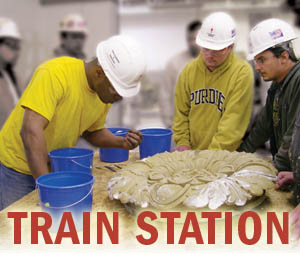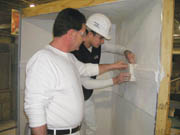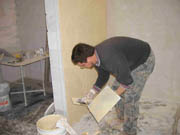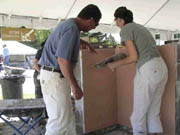
The plaster industry is straddling two worlds: classic materials and methods of the past, side by side with new products like coatings for autoclaved aerated concrete. The common element for both directions is the need for proper training.
A systematic approach for meeting both those needs is offered by the International Masonry Institute. IMI is a joint labor/management cooperative program of the International Union of Bricklayers and Allied Craftworkers and union contractors. In addition to numerous BAC plaster training efforts at the local level, IMI provides a framework for meeting both long range and immediate plaster training needs.

Learning curves ... among other surfaces
For entry-level plaster training, IMI continuously runs a 12-week pre-job course at the BAC/IMI National Training center, in Maryland, plus regional centers throughout the country. The course covers traditional three-coat plaster with rock and metal lathe, traditional three-coat stucco, Venetian plaster and ornamental plaster, EIFS, and AAC coatings.The approach produces apprentice craftworkers who are able to start working with a level of skill and familiarity dramatically more productive than the on-the-job, "sink or swim" approach. Just as importantly, it trains them in critical workplace behavior such as safety awareness and professionalism.
For BAC journeymen, IMI offers training in specialized products, such as AAC coatings and new acrylic veneers, to keep up with industry trends. There is also renewed demand for upgrade training in classics, such as Venetian plaster and Marmorino.
Recent projects with historical plastering techniques at IMI headquarters in Annapolis' historic Brice House (built circa 1776) has given the Institute the ability to offer specialty training courses in classic techniques.
Next up is a specialized AAC coatings course series that teaches all aspects of AAC coatings, including spray applications. The BAC/IMI training system offers it to BAC and IMI instructors, which allows for rapid deployment of local programs as needed.

All about EIFS
Another key program is EIFS education and certification. Using a core program developed by the Association of the Wall and Ceiling Industries-International, IMI continuously trains and certifies BAC and IMI instructors. That approach allows for tuning the program to local needs. In Chicago, where the program was launched, it is offered in English and Spanish, with testing proctored by AWCI.A recent AWCI certification course offered in Michigan included three contractors eager to take the class.
"It's an important certification for plasterers to have," says Daryl Nichols, a member of the BAC Labor-Management Plaster Craft Committee and Local 9 MI organizer who was instrumental in launching the Michigan program. "It's coming up on the prints. We like to get ahead of the curve here, so when it comes, we're ready."
The EIFS "Smart Contractor" designation "is a good selling point for the contractor," says Steve Nelms, Plaster Programs Coordinator at the BAC District Council Training Center, in Chicago.
IMI works closely with BAC officials to monitor regional markets and tailor custom training programs in their areas, whether the contractors want to bring in new people to the trade, or are interested in cross-training craftworkers.
"It's all about the needs in the field," says IMI/BAC Local 9 MI Training Center Director Tom McCord. "We are always networking with the contractors. Once they learn about the training options, that gives them the incentive to bid bigger work."
Contractors are encouraged to drop in and observe classes and offer input.

You're hired
At the end of the last 12-week plaster pre-job session, "they were hiring right on the spot," says McCord. A recent upgrade class there covered AWCI certification, Synergy products, molding and safety training. Nichols, who learned the plaster trade decades ago on the job, wishes he had learned the IMI way: "It helps out enormously," he says.Wisconsin BAC field representative Owen Jones keeps close tabs on contractors in his area. When needs arise, he calls IMI, "because I want them to learn the right way." The BAC's last round of classes included sessions in upgrade and EIFS training.
The training doesn't stop in the field. IMI keeps BAC and IMI instructors up on the latest industry trends and exposes them to all masonry crafts, including plaster, at its annual Instructor Certification Program. New ICP attendees start with a plaster familiarization course and progress through more advanced topics. The stucco class, for example, covers ASTM standards for preparing and applying stucco mixes, proper lath application, accessory installations and materials curing. The exterior installation course combines technical information and hands-on applications. ICP also covers industry basics, such as safety and health codes, while offering professional courses to improve instructors' teaching and human resource skills.
A third, critical part of the equation is the architect.
"We make sure their needs are being met through selective training," says Michigan's McCord. "This gives them confidence that we can deliver what they design or specify-to their specifications."
And it's never to soon to send that message. IMI's Masonry Camp is based on the belief that designers need to learn at the beginning of their careers both the beauty of masonry crafts and the value of proper training. The annual program brings together young architectural interns, graduate students and apprentice masons, helping them understand the benefit of designer/craftworker collaboration, and giving them hands-on exposure to all BAC masonry crafts: plaster, brick and block, tile, terrazzo, stone and restoration.
For many Masonry Camp participants, the plaster session offers a glimpse into a world they rarely see. By week's end, when a design/build challenge is translated into plans and mockups, the fascination with plaster is obvious, as entry after entry finds ways to incorporate some version of it, from exterior finish to stucco to colorful interiors.
IMI National Apprenticeship and Training Director Steve Martini says the demand for plaster training at all levels is getting stronger.
"Particularly over the last 12 months," he explains, "the demand for specialty materials in plastering has increased dramatically. Our training effort is geared up and responding to that demand."

Report Abusive Comment